Menus
- Enduros from Beta, Husaberg, Husqvarna and KTM in the test
- Beta RR 4T 350
- Husaberg FE 390
- Husqvarna TE 310
- KTM 350 EXC-F
- Off-road rating / test result
- Technical specifications

Jahn
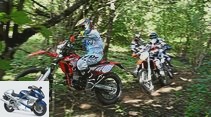


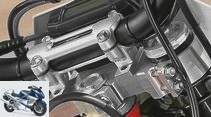
16 photos
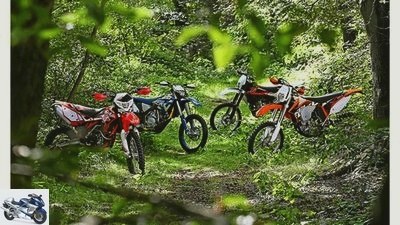
Jahn
1/16
In comparison test: Beta RR 4T 350, Husaberg FE 390, Husqvarna TE 310 and KTM 350 EXC-F.
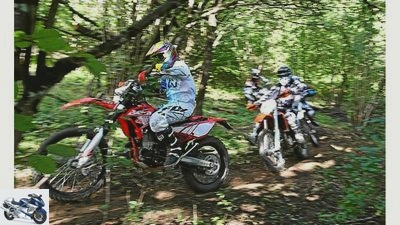
Jahn
2/16
Beta RR 4T 350 followed by the KTM 350 EXC-F.
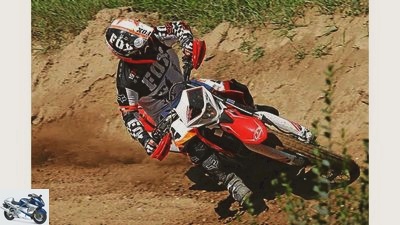
Jahn
3/16
Beta RR 4T 350 – Right in the thick of it, not just there: Beta has made a name for itself in the enduro profession in record time, not least thanks to its first-class workmanship. A reputation that the lively and sophisticated dohc engine reinforces.
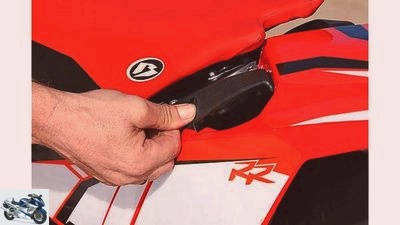
Jahn
4/16
Beta: bench that can be removed at the push of a button.
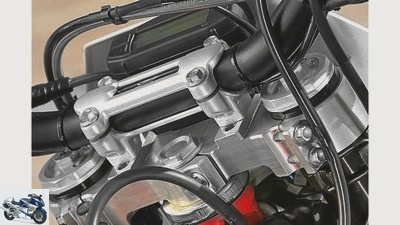
Jahn
5/16
Milled fork bridge with adjustable position of the handlebars on the Beta.
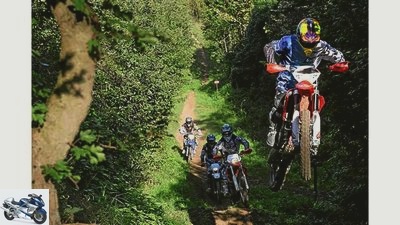
Jahn
6/16
With the tested enduros you can have a lot of fun off the beaten track.
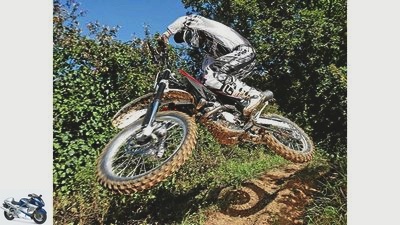
Jahn
7/16
Husqvarna TE 310 – Tilted? For years, the Husqvarna enduros shone with great traction and ease of control. Meanwhile, the Italians taken over by BMW run the risk of being left behind technically.
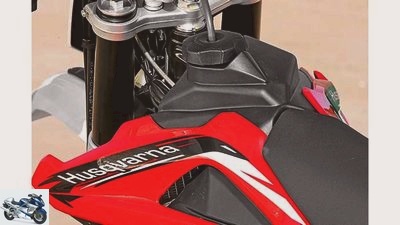
Jahn
8/16
The layout (hump on the tank) looks a bit antiquated at Husqvarna.
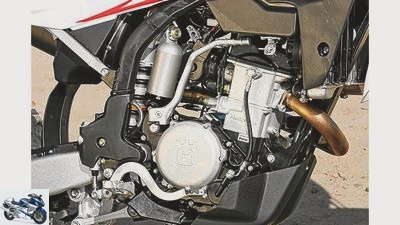
Jahn
9/16
The Husqvarna’s 302cc engine runs rough.
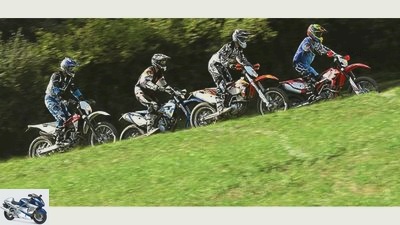
Jahn
10/16
Husqvarna TE 310, Husaberg FE 390, Beta RR 4T 350 and KTM 350 EXC-F.
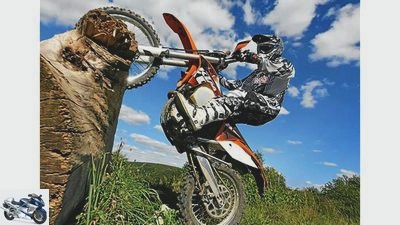
Jahn
11/16
Over all hurdles: With no-frills technology, KTM is setting a milestone in the enduro profession with the 350 concept. Whether enduro, cross country or motocross – the EXC-F is vastly superior to the competition in all areas. This bike is awesome.
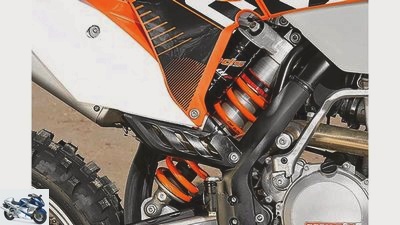
Jahn
12/16
Directly hinged PDS strut on the KTM.
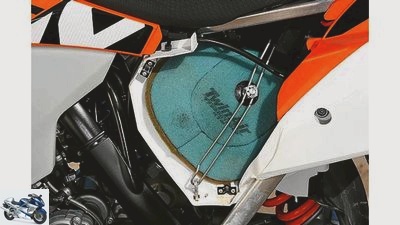
Jahn
13/16
Also with the KTM – air filter accessible without tools as is typical of the class.
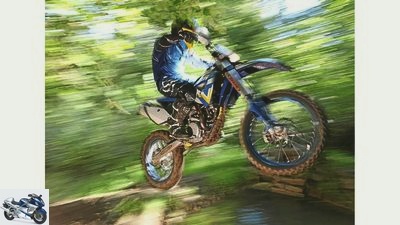
Jahn
14/16
Husaberg FE 390.
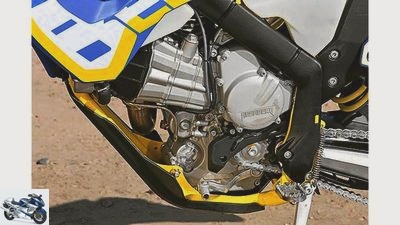
Jahn
15/16
The suction noise from the tank area requires getting used to at Husaberg.
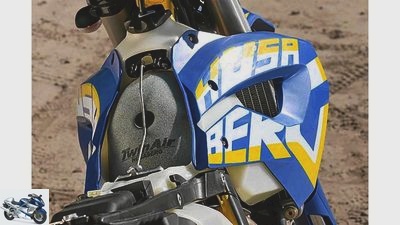
Jahn
16/16
Upright: The unconventionally built-in motor makes sense. The crankshaft moves towards the center of gravity of the vehicle, the retracted frame beams increase the ground clearance. Even in the 390 version, the strengths of the Husaberg remain unchanged: traction and efficiency.
Comparison test: 350 cc sports enduro bikes 2011
Enduros from Beta, Husaberg, Husqvarna and KTM in the test
With a displacement of around 350 cm³, the currently flourishing sport enduro trend should offer the golden mean between easy drivability and sufficient performance. The tide is turning in enduro sport?
It is nothing new that success in off-road sports depends on a lot, but certainly not on top performance. Drivability is the magic word that opens the treasure trove of success off the beaten track. On slippery terrain, you need to be easy to adjust; on broken paths, low engine reactions help, which allow the suspension to work sensitively. And agile handling not only ensures fast lap times, but also protects the driver’s stamina. Demands that are not easy to meet with 450 enduro bikes – especially in the hands of amateur riders. There have been trials with reduced-displacement concepts for a long time, but only the one presented in June KTM 350 EXC-F is now finally focusing on the new middle class.
Buy complete article
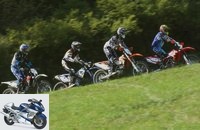
Comparison test: 350 cc sports enduro bikes 2011
Enduros from Beta, Husaberg, Husqvarna and KTM in the test
KTM 450 EXC, this relegated to second place. Can the competition from Beta, Husaberg and Husqvarna hold up? The sabers are sharpened, the tires (Michelin Enduro Competition III) are identical, the terrain is ideal. Two motocross routes (sand and hard ground) and a stony off-road terrain range from traditional enduro sports and modern cross-country activities to the important detour to the motocross slope during training. A range that, in addition to the final rating, also allows a specified ranking for the two main areas of application, cross country or enduro.
Beta RR 4T 350
Jahn
Beta RR 4T 350 – Right in the thick of it, not just there: Beta has made a name for itself in the enduro profession in record time, not least thanks to its first-class workmanship. A reputation that the lively and sophisticated dohc engine reinforces.
Since the 2010 season at the latest, the competition should finally take the Italians seriously. Since then, the men from the vicinity of Florence have been equipping their enduros with in-house engines instead of KTM’s supplier engines. Two overhead camshafts, valve actuation via rocker arms and two separate oil circuits for the engine and gearbox – this puts the Single at the top end of current enduro engine technology. The engineers only pinched one injection, instead relying on the tried and tested Keihin flat slide carburetor. New for 2012: a reinforced valve and primary drive, more voluminous frame beams, a front fork from Sachs (previously Marzocchi) – and of course the 350cc variant.
Just like its 450 sister so far, it is particularly popular with the smooth running of the engine. How cultivated the single already behaves just above idle speed, how lively it revs up to later redefine the current speed limit in the 350 bearing with a maximum speed of 12,600 rpm – that’s impressive. The Italo engine is lively on the gas, especially on motocross slopes. The low internal friction and moderate vibrations almost encourage you to turn down gears.
As much fun as the speed orgies on the motocross or cross-country track with the neon red can be, in the enduro terrain you sometimes need an experienced hand on the throttle. While the single-cylinder can be maneuvered sensitively through rough terrain in trial-like passages with the aforementioned first-class smoothness, the lively short-stroke occasionally tears through the rear wheel prematurely on stones or wet ground from the middle speed range and shows less traction than the three competitors. A shortcoming in classic enduro, less significant on the mostly smooth cross-country slopes.
Especially since the Florentine has the situation largely under control on the chassis side. The Sachs shock absorber, activated via a deflection, covers the bandwidth between Enduro and Motocross well. The front fork is sensitive, but should be more progressive for more reserves on hard landings or deep braking waves. What is also noticeable: Larger pilots feel extremely comfortable on the Beta thanks to the high steering head and the more generous amount of space. However, this makes it more difficult for smaller riders to load the front wheel in turns.
Is there anything else to complain about? Yes. In order to adjust the rebound damping of the front fork, the handlebars first have to be removed, the stickers peel off quickly and the gearshift lever needs getting used to. Because the lively Beta is set apart with competitive power (45 HP), nice details (seat unlocking at the push of a button, plastic frame rear), it is also part of the enduro leadership circle in the new 350 version.
Husaberg FE 390
Jahn
Husaberg FE 390.
The engine almost tilted upright, the tank pulled under the seat and the rear frame made of plastic – even three years after its presentation, the Husaberg technology caused a sensation. Especially because this concept is not an end in itself. The crankshaft and fuel supply move significantly closer to the center of gravity for agile handling, while the frame beams pulled back provide more ground clearance. The fact that the exiled Swede, manufactured by KTM, anticipated the current trend of downsizing with the 390 cm³ version in the 2010 season is not surprising given her focus on the best possible drivability and efficiency. The marginal modifications for the 2012 model year (yellow instead of blue frame, changed rigidity of the triple clamps, transparent tank) do not change anything. The trickier the terrain, the more the pilot appreciates the driving experience on the 390. Adjust the engine power with the clutch, move the light front wheel in steps, consciously load and relieve the rear wheel with short thrusts – that’s how the FE wants to be driven. By the way, it skilfully conceals the heaviest total weight in comparison with 117 kilograms.
What if the stylish climbing tour fails? It doesn’t matter, then the wonderfully easy-to-dose engine with the highest torque in this class up to mid-speed plows the load with high traction and calmly through thick and thin.
There is no light without shadow: the ohc single adorns itself when it comes to cross-country or even motocross inserts, reluctantly turns up. The fact that the suspension now offers slightly larger reserves compared to earlier models makes a trip into brisk terrain with the “Berg” hardly more efficient – even if the successful ergonomics, the precise steering behavior or the excellently controllable brakes still allow room for improvement. Nevertheless, the clear focus on the traditionally oriented enduro sport gives the Husaberg a lot of friends – even if they will probably also take a look at the relatives in orange from now on.
Husqvarna TE 310
Jahn
Husqvarna TE 310 – Tilted? For years, the Husqvarna enduros shone with great traction and ease of control. Meanwhile, the Italians taken over by BMW run the risk of being left behind technically.
Instead of barreling down 450 engines like Beta and Husaberg, Husqvarna goes the opposite way. The TE 310 has been based on the quarter-liter model since the 2009 season, and with 302 cm³ it takes the most radical path in the test field in terms of self-restraint. This has advantages (with 112 kilograms the second lowest weight in the test field) but also disadvantages (with 39 HP at least six horses less than the competition). Reinforced frame, new shock absorbers from Kayaba instead of Sachs – with these changes, the 2012 Husqvarna moves into the thicket. And with their unmistakable driving experience. Because traction is what the Italian shows off.
No matter how greasy the terrain is: open the gas and the dohc engine fed by a Mikuni injection pushes the load forward stoically. With the support of the soft suspension, the wheels stick to the ground. However, the finesse falls by the wayside. The liveliness expected from the small-displacement engine is missing, as is the agile handling expected from the weight advantage. Above all, the surprisingly sluggish engine that vibrates at higher speeds slows down the fun both in the forest and especially on the cross-piste. If you add the mediocre workmanship to this, not even the front end, which is extraordinarily strong in turns, or the good brakes do not dampen the disappointment. In the fourth year after the takeover of Husqvarna by BMW, one would have expected more when it comes to the facelift of the TE models.
KTM 350 EXC-F
Jahn
Over all hurdles: With no-frills technology, KTM is setting a milestone in the enduro profession with the 350 concept. Whether enduro, cross country or motocross – the EXC-F is vastly superior to the competition in all areas. This bike is awesome.
Let’s make it short: The 350 EXC-F wins this exchange of blows in a way that no competitive enduro has ever done in the recent history of MOTORRAD off-road comparison tests. Whether in the undergrowth, on a tricky cross-country meander or on the motocross slope, the 350 always sets the pace. And even if it sounds like an advertising text: It is the lightest, the strongest, the handiest, the most traction, the most universally coordinated and the liveliest. Why? Because the 350 EXC-F is not a modified version of an existing model, but was designed to fit precisely for this displacement category.
Off-road rating / test result
Jahn
Husqvarna TE 310, Husaberg FE 390, Beta RR 4T 350 and KTM 350 EXC-F.
| Max points | beta | Husaberg | Husqvarna | KTM | engine | 120 | 98 | 95 | 84 | 100 |
| landing gear | 100 | 77 | 81 | 76 | 86 | miscellaneous | 30th | 23 | 22nd | 23 | 25th | Overall rating | 250 | 198 | 198 | 183 | 211 |
engine
Special praise for Beta Husaberg and KTM. The trio delivers top ratings in almost all engine rating criteria. Not very pleasant: the powerful vibrations of the 310 Husky motor.
landing gear
Perfectly coordinated in all areas of application: the KTM suspension elements. Less good: the Husqvarna’s fork, which is far too soft for cross country. After all, the TE 310 enables energy-saving driving with reassuring straight-line stability.
miscellaneous
Great: Despite the lighting system and electric starter, the KTM only weighs 109 kilos. The Husaberg weighs the most at 117 kilos.
Test result
KTM 350 EXC-F
Whether cross-piste, special stage or hardcore enduro – the 350cc KTM doesn’t give the competition the slightest chance. A victory across the board.
Beta RR 4T 350
Especially with its lively and sophisticated engine, the beta makes friends, especially on the cross-country track. Incidentally, with great workmanship and equipment too.
Husaberg FE 390
Best torque, plenty of traction and great handling – the Husaberg shines with traditional strengths for enduro sports. The unorthodox technical concept is still appealing.
Husqvarna TE 310
Traction alone is no longer enough. With a rough engine, sluggish handling and mediocre workmanship, the former flagship Enduro TE 310 is gradually losing its technical connection.
Technical specifications
Jahn
With the tested enduros you can have a lot of fun off the beaten track.
| beta | engine |
| design type | Water-cooled, single-cylinder four-stroke engine with four valves | Valve train | dohc |
| Bore x stroke | 88 x 57.4 mm | Displacement | 349 cc |
| compression | 13.3 | Power* | 33.4 kW (45 hp) at 12,000 rpm |
| Carburetor / injection | Carburetor | diameter | 39 mm |
| Corridors | 6th | landing gear |
| frame | Single-loop frame made of tubular steel | fork | Sachs |
| Guide tube diameter | 48 mm | Strut | Sachs |
| Weight (without petrol) * | 115 kg | Price without additional costs | 8590 euros |
| Husaberg | engine | design type | Water-cooled, single-cylinder four-stroke engine with four valves | Valve train | ohc | Bore x stroke | 95 x 55.5 mm | Displacement | 393 cc | compression | 11.1 | Power* | 33.4 kW (45 PS) at 9900 rpm | Carburetor / injection | injection | diameter | 42 mm | Corridors | 6th | landing gear | frame | Single-loop frame made of tubular steel | fork | WP suspension | Guide tube diameter | 48 mm | Strut | WP suspension | Weight (without petrol) * | 117 kg | Price without additional costs | 8695 euros |
| Husqvarna | engine |
| design type | Water-cooled, single-cylinder four-stroke engine with four valves | Valve train | dohc |
| Bore x stroke | 82 x 57.4 mm | Displacement | 302 cc |
| compression | 13 | Power* | 28.6 kW (39 hp) at 9500 rpm |
| Carburetor / injection | injection | diameter | 45 mm |
| Corridors | 6th | landing gear |
| frame | Single-loop frame made of tubular steel | fork | Kayaba |
| Guide tube diameter | 48 mm | Strut | Kayaba |
| Weight (without petrol) * | 112 kg | Price without additional costs | 8499 euros |
| KTM | engine | design type | Water-cooled, single-cylinder four-stroke engine with four valves | Valve train | dohc | Bore x stroke | 88 x 57.5 mm | Displacement | 350 cc | compression | 12.3 | Power* | 34.3 kW (47 hp) at 11,900 rpm | Carburetor / injection | injection | diameter | 42 mm | Corridors | 6th | landing gear | frame | Single-loop frame made of tubular steel | fork | WP suspension | Guide tube diameter | 48 mm | Strut | WP suspension | Weight (without petrol) * | 109 kg | Price without additional costs | 8695 euros |
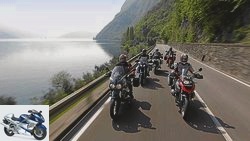
Enduro
Enduros up to 1200 cm³ in comparison
Megatest: travel enduros
read more
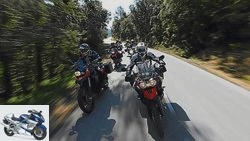
Enduro
Megatest Enduros 2011
The enduro mega test part 1: travel enduros up to 800 cm³
read more
Related articles
-
Sports enduro bikes from Gas Gas, Husqvarna and KTM put to the test
Zamponi 45 photos Zamponi 1/45 Off with the sports enduro into a huge private forest! Contrary to popular belief, enduro riding is prohibited in public…
-
350cc sport enduro bikes from Beta, Husqvarna, KTM and Sherco in a comparison test
Gargolov 22 pictures Gargolov 1/22 350 series enduro bikes in comparison: Beta RR 350 EFI, Husqvarna FE 350, KTM 350 EXC-F and Sherco 300 SEF-R. Gargolov …
-
Comparison test of 600 sports enduro bikes
Comparison test of 600 sports enduro bikes Too much … … power? That is impossible. There is no substitute for displacement, you can’t get enough power …
-
Comparison test of 250 cc sports enduro bikes
fact comparison test of 250 cm³ sport enduro rangers Less is more? Maybe with the motorized forest run. The new 250cc enduro bikes …
-
Comparison test: 450cc sport enduro bikes
Jahn comparison test: 450cc sport enduros Four 450cc sport enduros in an off-road comparison If two do the same thing, it is far from the same: While …
-
Comparative test of 450 cc sport enduro bikes
Llurba comparison test of 450 cc sport enduro bikes All nine T he highest sales figures, the fastest lap times, the highest priority – the …
-
Comparison test of sports enduro bikes KTM 450 EXC and Yamaha WR 450 F
markus-jahn.com 23 pictures markus-jahn.com 1/23 Yamaha flies with the WR 450 an attack on the high-flyer 450 EXC from KTM. markus-jahn.com 2/23 KTM …
-
Beta sports enduro bikes (model year 2018) in an individual test
Beta 9 pictures Beta 1/9 The new Beta RR 125 2T in the driving report. Beta 2/9 flat piece: The narrower coupling enables a flatter …
-
Comparison test: seven enduro bikes in Sweden
Jahn 28 pictures Jahn 1/28 The operation of the Multistrada has also changed: A control center for electronics and motor directly on the handlebar. Jahn 2/28 …
-
Enduro comparison – off-road bikes from Beta, Honda, Yamaha and KTM
Monnich 24 pictures Monnich 1/24 With the Freeride 350, KTM is taking responsibility for the off-road scene. The competition: Yamaha WR 250 R, Honda CRF 250 L, …